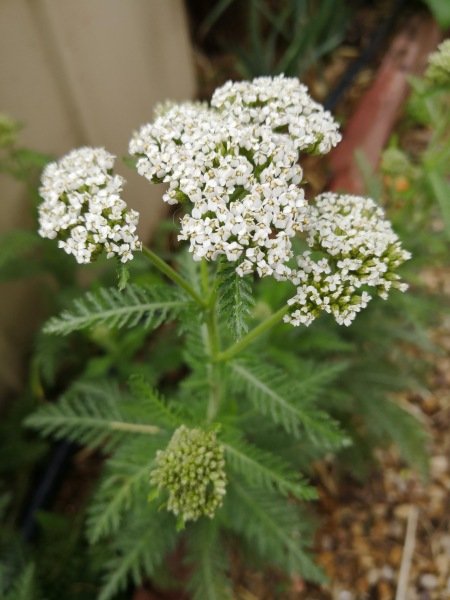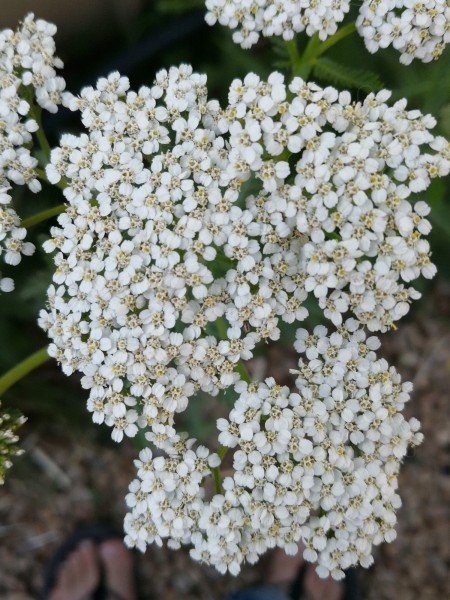Hi Herbal Hiveans. Here's the next in my new series of posts covering how to use the herbs in our garden. You can find the earlier ones by wandering back through my blog. Once I've quite a few, I'll make an index page for them for your ease of use. This installment is about Yarrow.
This is the last post in this series but If you can comment below and let me know if you found them valuable, I could restart from the beginning and include new information in the earlier posts. I'm always learning here and there and there is enough new info warrant the effort.

Common names: Yarrow, Common Yarrow
Taxonomic name: Achillea millefolium
Family: Asteraceae
Uses: Divination, compost, bleeding with bright red blood, fevers, cold and flu, stomach ache
Area of origin: Asia, Europe, North America
Warnings: None
Yarrow (Achillea millefolium) is as interesting as its botanic name ‘Achillea millefolium‘ suggests.
‘Achillea‘ refers to the Greek Hero, Achilles who is reputed to have used this herb on the battlefield to heal the wounds of both his soldiers and his self (though not, apparently, the one that made him famous).
‘Millefolium’ means, literally ‘thousand leaves’. If you take a look at a Yarrow plant, it will appear to have thousands of leaves, each divided to look like more leaves. There can be a bit of a difference between the leaves of varieties of Yarrow, for instance, those of the white and yellow varieties on this page, but the overall trend is there.
If you look at the flower head, you might wonder why it isn’t named ‘milleflora‘ because it seems to have thousands of flowers too. The more traditional, white flowered plant is best for medicinal uses. There are many other colours cultivated now, from yellow to purple.

We use Yarrow as an edging plant. The White variety likes to run.
Yarrow is a first aid herb. When you see fresh, red blood, think of Yarrow. It excels at those arterial cuts that spurt blood. Crush it up and apply the wad of crushed material directly to the wound and it will help it a lot. Compare this to Shepherd’s Purse which is indicated in wounds that have dark, sluggish, oozing blood.
In Germany, Yarrow is named ‘Bauchwehkraut‘ or ‘Belly Ache Weed’. It has long been indicated for gastro-intestinal complaints and digestive disorders. It is also used for menstrual problems.
Like Elder Flower tea, a couple of hot cups of Yarrow tea will kick up a sweat and help in getting rid of colds and flu. That property is called ‘diaphoretic’ in herbalism. The same tea can help with internal bleeding (though you should see your GP about that as well). This makes Elder and Yarrow a great combination in teas for colds.
Another interesting use is the one that the Chinese put Yarrow too. Besides being a useful herb, dried Yarrow stalks are used when casting for the I -Ching, a form of divination. Interestingly, European tradition has that if you hold Yarrow against your forehead, it can give second sight.
Yarrow is also a key garden plant because some of the goodies it contains promotes the growth of microbes and positively affects other processes in composting, speeding it up and enriching the final product. I used to like I to grow a plant or two, along with Comfrey near to our compost bin so that I could throw a few leaves in when I’m making a batch of compost.
With its nutritional and medicinal properties, Yarrow makes an excellent fodder and first aid plant for livestock. When allowed, they will forage it as they need it.
When you gather Yarrow from your garden, it is best to do so in the dry weather (something we’re not short of here in Australia!). That’s when the oils are at their strongest and most therapeutic.
Making a tea from this herb
To make tea, simply place a teaspoonful or two of dried or fresh herb into a cup of hot water. Cover the cup while the brew steeps so that you don't lose any of those precious oils.







I did like this series and if you have new plants to post about, I'd love to read about them.
Thats one vote! I'll probably do it, there's enough new info to add value to the posts and te work won't be difficult as many of them were already posted ages ago. I just hope there's enough difference to escape the wrath of @hivewatchers
I never managed that, with some of my informational posts, so I gave up....
Lets see how it goes...
Once again this tends to be used more as fodder in our place. It's hardy enough to survive my neglect, however, so it stays.
@tipu curate
Upvoted 👌 (Mana: 41/51) Liquid rewards.
They say that your food should be your medicine 💊